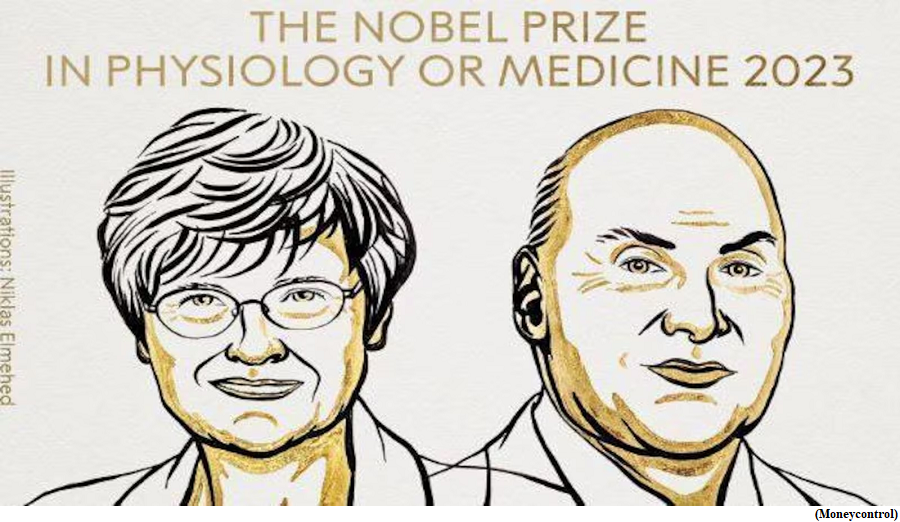Nobel Prize 2023 in Medicine (GS Paper 3, Science and Technology)

Why in news?
- The Nobel Prize in Physiology or Medicine for 2023 has been awarded to Katalin Kariko, and Drew Weissman for their discoveries concerning nucleoside base modifications that enabled the development of effective mRNA vaccines against Covid-19.
Details:
- Katalin Karik, who was born in 1955 in Szolnok, is Professor at Szeged University and an Adjunct Professor at Perelman School of Medicine at the University of Pennsylvania.
- Meanwhile, Drew Weissman is a Roberts Family Professor in Vaccine Research and Director of the Penn Institute for RNA Innovations.
What are mRNA vaccines?
- mRNA or messenger RNA, is a type of genetic molecule that plays a crucial role in the process of protein synthesis in cells. It serves as an intermediary between the DNA in a cell's nucleus and the ribosomes, which are cellular structures responsible for building proteins.
- It is also a crucial component of the central dogma of molecular biology, which describes the flow of genetic information in cells from DNA to RNA to protein. This makes it critical in delivering and activating antibodies against a viral infection.
- Messenger RNA (mRNA) vaccines, unlike traditional ones, do not use weakened or inactivated germs.
- They work by leveraging a small piece of synthetic mRNA to instruct cells in the human body to produce a harmless portion of the target pathogen (in this case, the spike protein of the SARS-CoV-2 virus, which causes Covid-19).
- Scientists employ lab-created mRNA to instruct our cells to produce a protein or a fragment of it, which triggers an immune response. This response, characterised by the production of antibodies, is what protects us from future infections.
Their discovery:
- Kariko and Weissman faced numerous challenges, including skepticism from the scientific community and a lack of funding when they started, they remained steadfast in their belief in the potential of mRNA as a therapeutic tool.
- Their perseverance paid off in 2005 when they made a key discovery: mRNA could be modified and effectively delivered into the body to activate the immune system.
- This breakthrough laid the foundation for the development of the Pfizer-BioNTech and Moderna's Covid-19 vaccines, which have proven to be safe and effective in preventing serious complications from the virus.
- Despite the success of mRNA vaccines, challenges remain, such as ensuring stability, translation efficiency, and the immunostimulatory potential of exogenous mRNA. However, the rapid development and large-scale production of mRNA vaccines during the Covid-19 pandemic have demonstrated their immense potential.
About 113 Nobel Prizes in Physiology or Medicine:
- So far, 113 Nobel Prizes in Physiology or Medicine have been awarded since 1901 of which 12 have been given to women.
- The youngest medicine laureate ever is Frederick G. Banting, who was awarded the 1923 Medicine Prize for the discovery of insulin at the age of 32.
- The 2022 Nobel Prize in Physiology or Medicine was awarded to Swedish geneticist Svante Paabo. Paabo, who directs the Max Planck Institute for Evolutionary Anthropology in Leipzig, Germany, was recognised for his groundbreaking work in extracting and analysing DNA from ancient bones, particularly those of Neanderthals.
Kashmir bat industry hits its sweet spot after 102 years
(GS Paper 3, Economy)
Why in news?
- For the first time in the 102 years of its manufacturing history in the Valley, the Kashmir bat will be used in 50-over World Cup matches.
- At the International Cricket Council (ICC) Men’s Cricket World Cup 2023, hosted by India and which begins on Oct 5, the Afghan team will be wielding the Kashmir willow.

Achievements:
- In November 2022, the bats tasted success when UAE player Junaid Siddique hit Sri Lankan bowler Dushmantha Chameera to a 109-metre six, making it the longest six in the T20 World Cup, and bringing the bats manufactured by their company into international focus.
Kashmir’s bat industry:
- Kashmir’s bat industry is mainly concentrated in south Kashmir’s Pulwama and Anantnag districts, with willow groves growing in the wet highlands nearby.
- Around 200 bat manufacturing units engage around 50,000 people for production. The female cultivar of white willow is considered the best for bats.
- Each cleft is expertly shaped, especially the middle spot and the toe blade. A bat weighing around 2 pounds and 7 ounces (a little over 1 kg) remains the most preferred bat globally.
Background:
- It was industrialist Allah Baksh from Pakistan who established the first cricket bat unit in Bijbehara’s Halmulla area in the 19th Century.
- It achieved the status of small scale industry by 1922.
- Bat clefts would be ferried through the Jhelum Valley road, getting its finishing touch at Sialkot in Pakistan. Then, they were used by the British, who introduced the game to India.
Way Forward:
- Around 75,000 willow trees are cut annually to keep the bat industry in the State ticking. A tree that attains a girth of 58 inches (147 cm or so) is felled for the bat industry. Manufacturers say the raw material is depleting now.
- The government needs to promote organised willow farming and maintain the supply as per the demand.



